L.A.’s Music Center was built as an aloof city on a hill. Can a remade plaza change that?
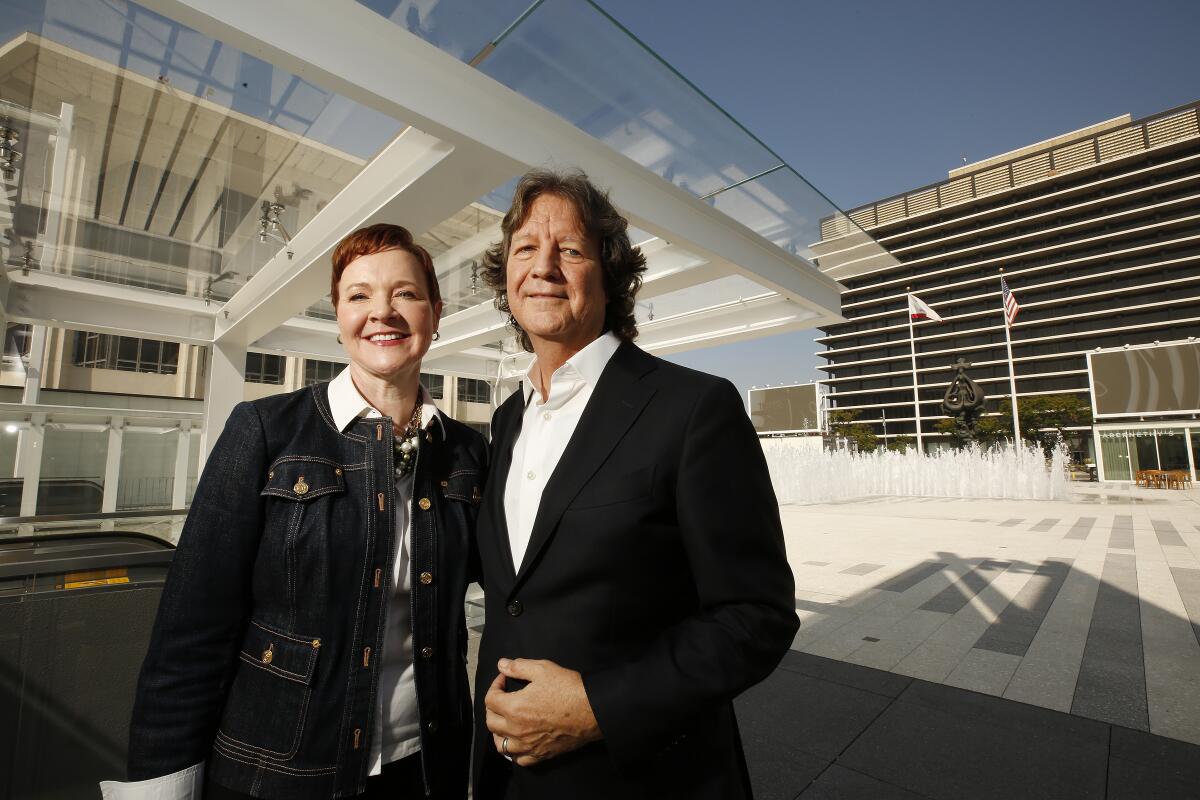
In 1964, when the first phase of the Music Center — the Dorothy Chandler Pavilion — opened in downtown Los Angeles, designer and painter Millard Sheets wrote a tribute to architect Welton Becket’s Modernist temple to the arts in the pages of The Times: “They have created a form that will stand high on the hill and high in spirit that will not be quickly dated or lacking in technical qualities needed for its function.”
Time has a funny way of rendering statements about timelessness obsolete.
“We shouldn’t be a white castle on the hill,” says Rachel Moore, president and CEO of the Music Center, seated earlier this month at a picnic table in the plaza of the complex on a brilliant L.A. morning, the kind that turns every gaze into a squint. “Our new vision is about deepening the cultural life of every resident in the county. That is a very outward vision.”
It’s a vision that has been ill-served by the Music Center’s aloof midcentury architecture, which has long stood, seemingly out of reach, a full story above Grand Avenue and the rest of the city, in a design that former Times architecture critic Nicolai Ouroussoff once likened to “the deck of an aircraft carrier.”
That should change, however, with the $41 million revamp of the Music Center’s new plaza by Rios Clementi Hale Studios, which opens to the public next week.
The redesign is less a full-blown re-do than a careful surgical intervention. It is intended to make the Music Center more flexible and functional, a space that can accommodate community dance nights as well as experimental outdoor theater. It also aims to improve the visual and physical links between the raised complex and the burgeoning pedestrian life on Grand Avenue and in Grand Park below — attempting to breathe some life into the urban spaces around the theaters, which generally only come alive in the hours before a show.
“The plaza,” says Moore, “is the physical manifestation of the changes to how we are programming.”
The guiding concept: accessibility.
Joining Moore on this warm weekday morning is the low-key Bob Hale, the architectural partner who led the redesign efforts on behalf of his firm.
“We really saw the ability to create access for everybody as both facilitating that access, but also providing opportunities that didn’t exist,” he says. “A lot of it is empowering people to be engaged in ways that they want to be engaged.”
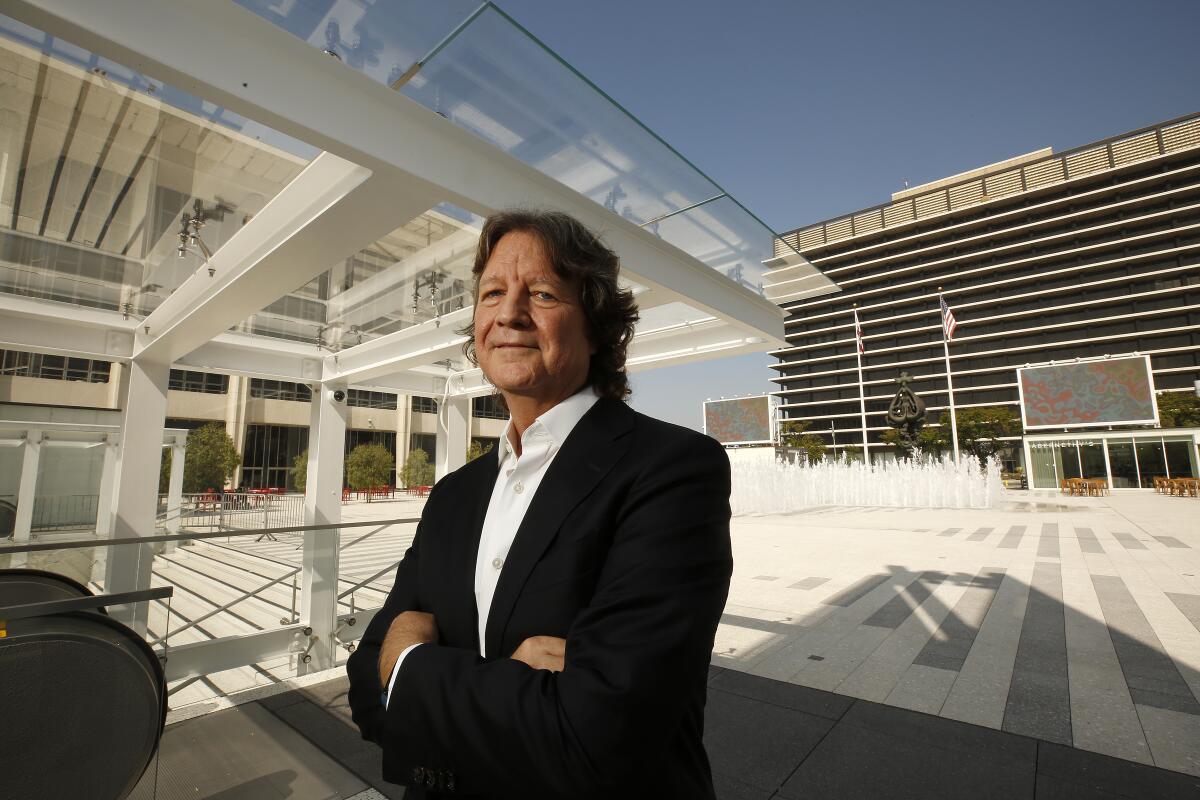
Hale’s team has left the basic geometries of the Music Center — Becket’s columned Dorothy Chandler Pavilion, the circular Mark Taper Forum and the boxy Ahmanson Theatre — untouched. But he has reworked the broad sunken plaza that brought them together. (The plaza was originally designed by the landscape architecture firm of Cornell, Bridgers and Troller in association with Becket.)
One of the issues with the 1960s-era design was the short cascades of steps around the plaza — leading up to the Dorothy Chandler Pavilion, down from Hope Street and up to the fountain, where Jacques Lipchitz’s massive bronze sculpture “Peace on Earth,” from 1969, occupied pride of place.
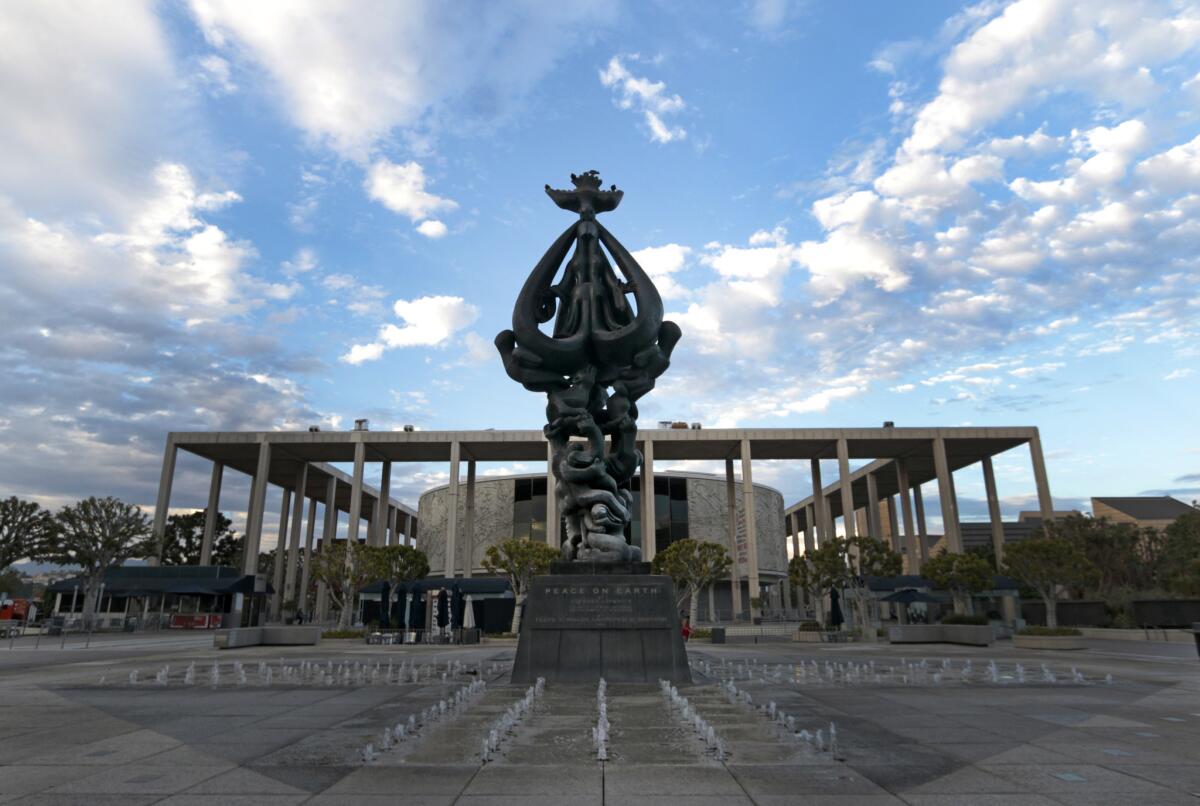
The stepped layout long created problems for patrons with mobility issues. And the advent of the Americans with Disabilities Act in 1990 brought with it a circuitous array of temporary ramps. While these solved accessibility issues, from the perspective of navigation (which was circuitous), not to mention aesthetics, it was an inelegant solution.
The new design raises the entire plaza up to a single level so that no steps or ramps are required to navigate its breadth. “Creating accessibility,” says Hale, “that was a big issue.”
Just as significant was the idea of opening the plaza to multiple uses.
Lipchitz’s bronze sculpture, once at the center of the fountain, has been relocated 100 feet to the northwest, along Hope St., where it forms an axis with the Department of Water and Power building and City Hall to the southeast. When the fountain is turned off, the plaza becomes a single expanse — the sort of space that can be used for music shows, dance performances, screenings, theatrical events and community happenings. (The Music Center is already behind Dance DTLA, the free outdoor dance parties that draw hundreds of people for music, grooving and dance lessons.)
“Art happens everywhere; it doesn’t just happen in a theater,” says Moore. “The kind of stuff this place will allow us to do speaks to the future of where the arts is. ... We don’t confer it on anyone. It’s a dialogue.”
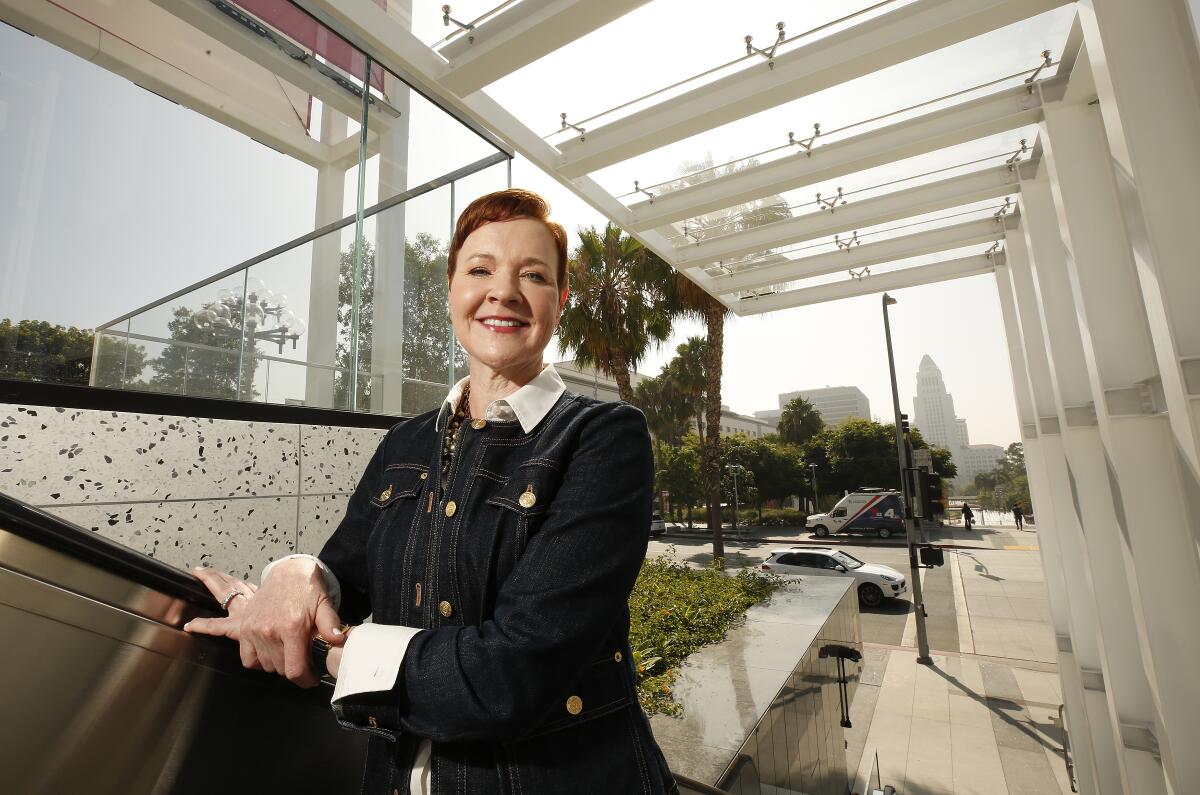
Part of the challenge was attempting to extend that dialogue beyond the insular architecture of the Music Center.
Like other cultural complexes of the era — the Los Angeles County Museum of Art, which opened in 1965, or Lincoln Center in New York City (1962) — the Music Center sat at a remove from the sidewalk, creating, quite literally, a space apart for the arts.
“It was very much an introverted place,” says Hale. “But Midcentury Modernism — that was what they did. They saw it as honoring the arts more consciously than making it elitist, but it resulted in a perception of an elitist place.”
In the case of the Music Center, it is a double whammy. The performing arts center not only hovers at least 10 feet above reach of the street, the whole compound is at the top of steep Bunker Hill. Furthermore, most of what passersby see when they walk past on Grand Avenue is infrastructural: a single restaurant (Kendall’s Brasserie) sandwiched between a loading dock and a pair of parking garage entrances. It’s almost as if the whole complex were saying, I dare you to visit.
There is an explanation for this: namely that the Grand Avenue side of the Music Center — the street from which the vast majority of its patrons approach it — isn’t the front of the complex, but the rear.
When Becket designed the place in the early 1960s, Bunker Hill was largely denuded after a wave of “slum clearance” efforts wiped away all the Victorian rooming houses that occupied the hillside. So the architect oriented the cultural compound toward Hope Street, where A.C. Martin’s Department of Water and Power (completed in 1965) was then under construction across the street.
“That was seen as the front door,” says Hale. Unfortunately,”the rest of the city didn’t follow suit.”
It was Grand Avenue, not Hope Street, that ultimately became the principal cultural corridor on Bunker Hill, attracting the Museum of Contemporary Art Los Angeles in the 1980s, followed by Frank Gehry’s Walt Disney Concert Hall in 2003, and the Broad museum in 2015. The arrival of Grand Park in 2012 (also designed by Rios Clementi Hale) further oriented life away from Hope Street.
For Hale, it was therefore important to create points of connection between the Music Center and the street — and to do it all without gutting the place. To achieve this, the architectural team once again took out their scalpels and made some careful incisions.
The principal concrete staircase that led from Grand Avenue up to the plaza was rebuilt at a shallower, more gradual angle to make it easier to navigate and allow for improved sightlines from the street up toward the complex. On either side of the steps, they added escalators under prominent glass canopies. Above these, large billboards mark the entrance to the Music Center.
In addition, a row of gray granite slabs that bear the names of important donors — “the tombstones,” Hale calls them — have been relocated from the Grand Avenue side of the complex, where they walled off the plaza from the street, to the new Lisa Specht Welcome Center, on Hope Street. It is here that visitors will be able to find information about programming and food options, of which there will now be many more.
Along with a burger stand (Upstage Burger) and a Mexican restaurant (Cocina Roja), both in operation, the plaza will see the addition of a bar (the Mullin Wine Bar), a coffee house (Go Get Em Tiger) and a sit-down restaurant, Abernethy’s (named for Music Center vice chair Robert Abernethy), which will give the stage to emerging Los Angeles chefs for three months at a time. Both the Mullin and Go Get Em Tiger sit at the edge of the Grand Avenue side of the property and will be visible from the street.
“Part of engaging the community is seeing what’s going on up here,” says Hale. “When you’re down on Grand Avenue, you’ll now be able to see people hanging out and drinking and eating and you’ll be able to see activity on the plaza.”
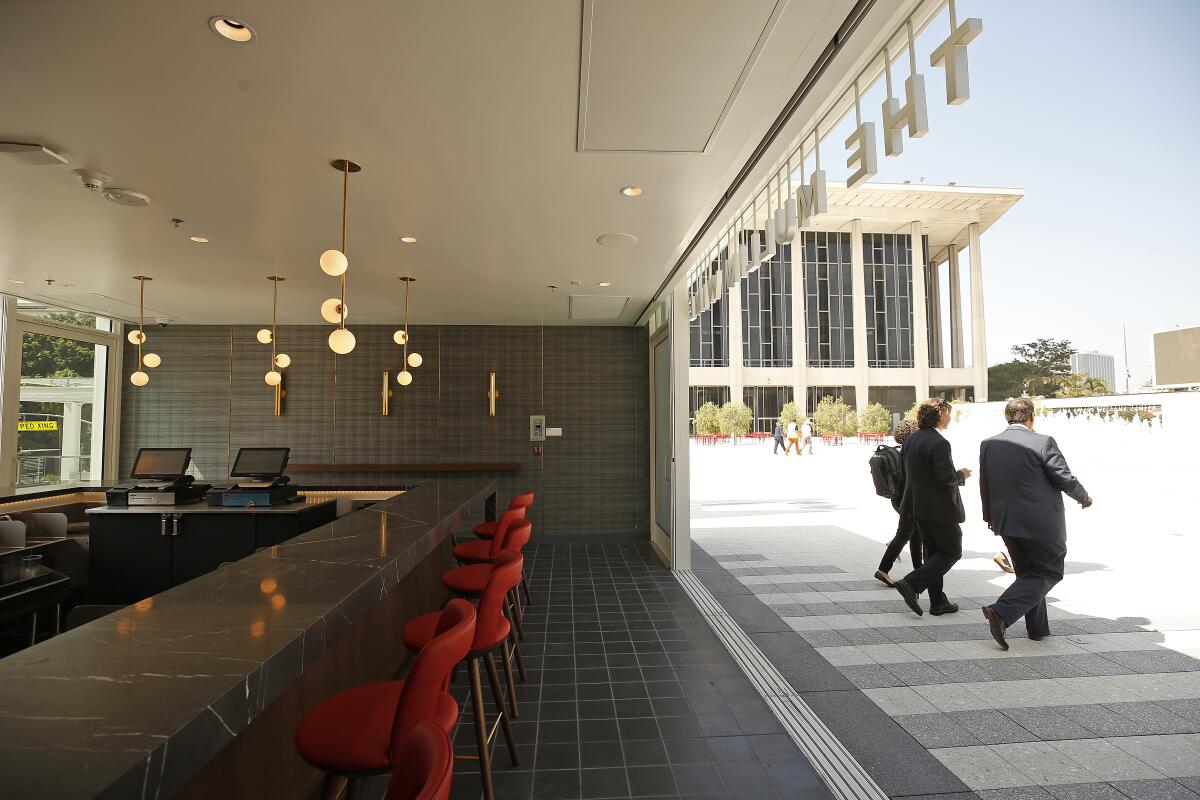
Also drawing visitors to the site will be a pair of large LED screens above the welcome center that can be employed for performance simulcasts, to display art or for interactive experiences.
“There will be nothing commercial,” says Moore. “We are working with yU+co — a digital studio in Hollywood — and they are working with our programming team for inventive ways of using the screens.”
This redesign has been almost two decades in the making.
In 2001, as Disney Hall was under construction across the street (it too is part of the Music Center), Gehry gathered a group of high-profile architects and designers to brainstorm “blue sky” concepts for improving the urbanism of the surrounding area.
One proposal suggested lowering the Music Center’s plaza to make it contiguous to Grand Avenue. That plan never got beyond the idea stage. (The Music Center sits on four split-level stories of parking garage, and to redo any of that would have been economically astronomical.) But it highlighted the need to contend with the center’s standoffish design.
Hale’s hope is that his work makes the center more accessible while preserving something of its character.
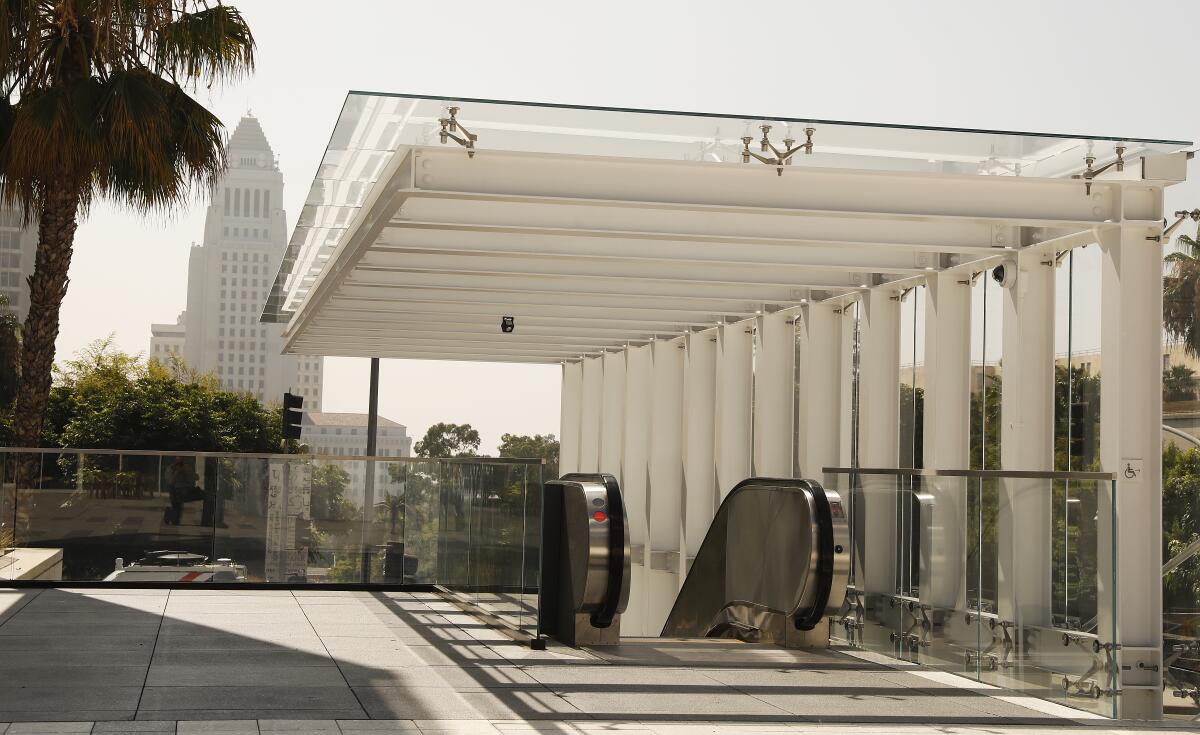
This is, after all, the spot where a youthful Zubin Mehta conducted violinist Jascha Heifetz. Where Edward James Olmos sauntered on stage as El Pachuco in the groundbreaking “Zoot Suit.” Where Mikhail Baryshnikov danced “The Nutcracker” just a few years after defecting. Where a 10-year-old Tatum O’Neal toted around a supporting actress Oscar she won for her role in “Paper Moon” (back when the Academy Awards ceremony was held at the Dorothy Chandler Pavilion).
“In a city like Los Angeles, our heritage isn’t so long,” he says. “But this is a place with heritage, so figuring out how to preserve that in a way that isn’t a white elephant, but is in fact renewed, seems like a better model.”

In the meantime, Moore and the rest of the team at the Music Center are looking at the ways they might begin to program the redesigned plaza. The first weekend is packed: with a cumbia dance jam on Aug. 30, a Master Chorale sing-a-long on Aug. 31 and a family-friendly splash party on Sept. 1.
Howard Sherman, the Music Center’s COO, says, “We want to not tinker for six months and let the plaza tell us what it needs.”
But Moore has ideas. “Maybe an awards show,” she says with a laugh.
Note to Hollywood: The plaza is open.
More to Read
The biggest entertainment stories
Get our big stories about Hollywood, film, television, music, arts, culture and more right in your inbox as soon as they publish.
You may occasionally receive promotional content from the Los Angeles Times.







